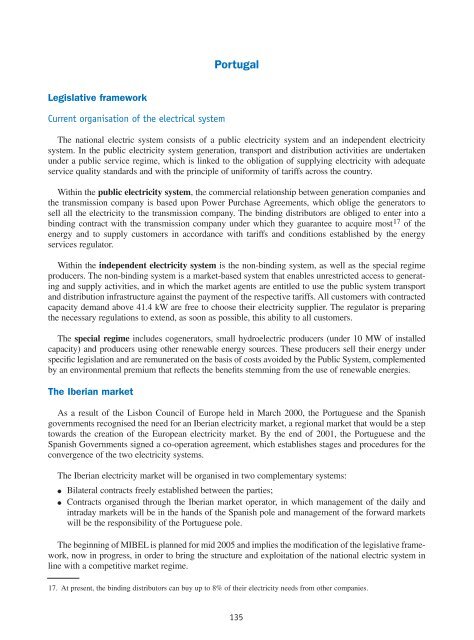Projected Costs of Generating Electricity - OECD Nuclear Energy ...
Projected Costs of Generating Electricity - OECD Nuclear Energy ...
Projected Costs of Generating Electricity - OECD Nuclear Energy ...
Create successful ePaper yourself
Turn your PDF publications into a flip-book with our unique Google optimized e-Paper software.
Portugal<br />
Legislative framework<br />
Current organisation <strong>of</strong> the electrical system<br />
The national electric system consists <strong>of</strong> a public electricity system and an independent electricity<br />
system. In the public electricity system generation, transport and distribution activities are undertaken<br />
under a public service regime, which is linked to the obligation <strong>of</strong> supplying electricity with adequate<br />
service quality standards and with the principle <strong>of</strong> uniformity <strong>of</strong> tariffs across the country.<br />
Within the public electricity system, the commercial relationship between generation companies and<br />
the transmission company is based upon Power Purchase Agreements, which oblige the generators to<br />
sell all the electricity to the transmission company. The binding distributors are obliged to enter into a<br />
binding contract with the transmission company under which they guarantee to acquire most 17 <strong>of</strong> the<br />
energy and to supply customers in accordance with tariffs and conditions established by the energy<br />
services regulator.<br />
Within the independent electricity system is the non-binding system, as well as the special regime<br />
producers. The non-binding system is a market-based system that enables unrestricted access to generating<br />
and supply activities, and in which the market agents are entitled to use the public system transport<br />
and distribution infrastructure against the payment <strong>of</strong> the respective tariffs. All customers with contracted<br />
capacity demand above 41.4 kW are free to choose their electricity supplier. The regulator is preparing<br />
the necessary regulations to extend, as soon as possible, this ability to all customers.<br />
The special regime includes cogenerators, small hydroelectric producers (under 10 MW <strong>of</strong> installed<br />
capacity) and producers using other renewable energy sources. These producers sell their energy under<br />
specific legislation and are remunerated on the basis <strong>of</strong> costs avoided by the Public System, complemented<br />
by an environmental premium that reflects the benefits stemming from the use <strong>of</strong> renewable energies.<br />
The Iberian market<br />
As a result <strong>of</strong> the Lisbon Council <strong>of</strong> Europe held in March 2000, the Portuguese and the Spanish<br />
governments recognised the need for an Iberian electricity market, a regional market that would be a step<br />
towards the creation <strong>of</strong> the European electricity market. By the end <strong>of</strong> 2001, the Portuguese and the<br />
Spanish Governments signed a co-operation agreement, which establishes stages and procedures for the<br />
convergence <strong>of</strong> the two electricity systems.<br />
The Iberian electricity market will be organised in two complementary systems:<br />
● Bilateral contracts freely established between the parties;<br />
● Contracts organised through the Iberian market operator, in which management <strong>of</strong> the daily and<br />
intraday markets will be in the hands <strong>of</strong> the Spanish pole and management <strong>of</strong> the forward markets<br />
will be the responsibility <strong>of</strong> the Portuguese pole.<br />
The beginning <strong>of</strong> MIBEL is planned for mid 2005 and implies the modification <strong>of</strong> the legislative framework,<br />
now in progress, in order to bring the structure and exploitation <strong>of</strong> the national electric system in<br />
line with a competitive market regime.<br />
17. At present, the binding distributors can buy up to 8% <strong>of</strong> their electricity needs from other companies.<br />
135

















